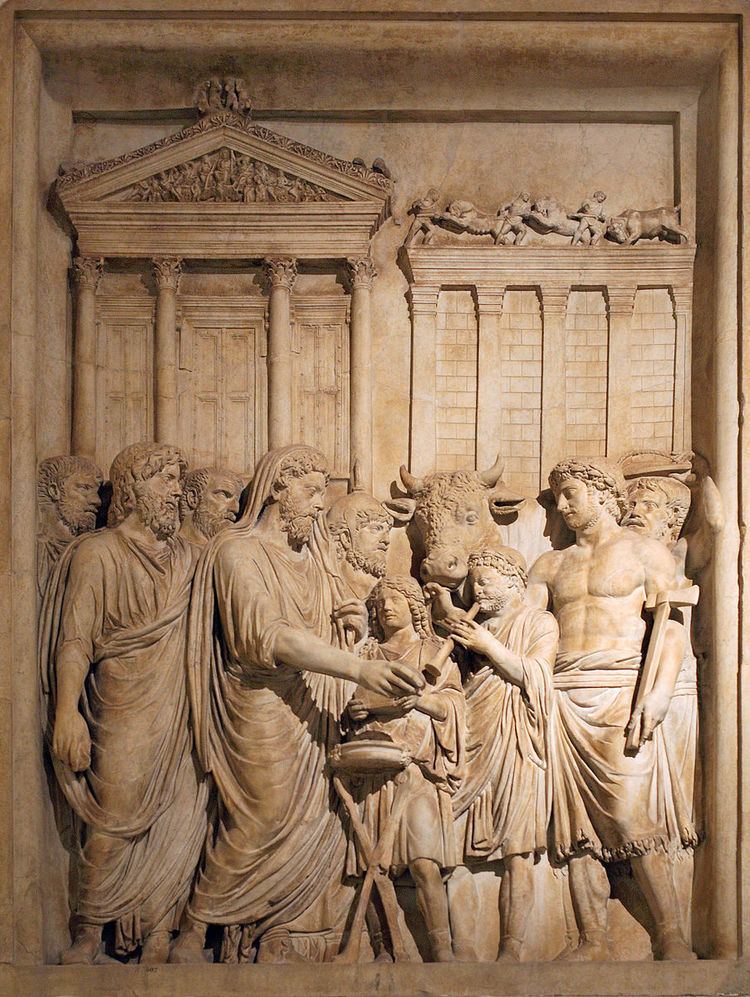 | ||
In ancient Roman religion, Summanus (Latin: Summānus) was the god of nocturnal thunder, as counterposed to Jupiter, the god of diurnal (daylight) thunder. His precise nature was unclear even to Ovid.
The temple of Summanus was dedicated during the Pyrrhic War c. 278 BCE on June 20. It stood at the west of the Circus Maximus, perhaps on the slope of the Aventine. It seems the temple had been dedicated because the statue of the god which stood on the roof of the temple of Jupiter Capitolinus had been struck by a lightningbolt. Every June 20, the day before the summer solstice, round cakes called summanalia, made of flour, milk and honey and shaped as wheels, were offered to him as a token of propitiation: the wheel might be a solar symbol. Summanus also received a sacrifice of two black oxen or wethers. Dark animals were typically offered to chthonic deities.
Saint Augustine records that in earlier times Summanus had been more exalted than Jupiter, but with the construction of a temple that was more magnificent than that of Summanus, Jupiter became more honored.
Cicero recounts that the clay statue of the god which stood on the roof of the Temple of Jupiter Optimus Maximus was struck by a lightningbolt: its head was nowhere to be seen. The haruspices announced that it had been hurled into the Tiber River, where indeed it was found on the very spot indicated by them.
The temple of Summanus itself was struck by lightning in 197 BCE.
Pliny thought that he was of Etruscan origin, and one of the nine gods of thunder. Varro, however, lists Summanus among gods he considers of Sabine origin, to whom king Titus Tatius dedicated altars (arae) in consequence of a votum. Paulus Diaconus considers him a god of lightning.
The name Summanus is thought to be from Summus Manium "the greatest of the Manes", or sub-, "under" + manus, "hand".
Georges Dumézil has argued that Summanus would represent the uncanny, violent and awe-inspiring element of the gods of the first function, connected to heavenly sovereignty. The double aspect of heavenly sovereign power would be reflected in the dichotomy Varuna-Mitra in Vedic religion and in Rome in the dichotomy Summanus-Dius Fidius. The first gods of these pairs would incarnate the violent, nocturnal, mysterious aspect of sovereignty while the second ones would reflect its reassuring, daylight and legalistic aspect.
According to Martianus Capella, Summanus is another name for Pluto as the "highest" (summus) of the Manes. This identification is taken up by later writers such as Camões ("If in Summanus' gloomy realm / Severest punishment you now endure …") and Milton, in a simile to describe Satan visiting Rome: "Just so Summanus, wrapped in a smoking whirlwind of blue flame, falls upon people and cities".
Summanus and Mount Summano
Traditionally Mount Summano (elevation 1291 m.), located in the Alps near Vicenza (Veneto, Italy) is considered a site of the cult of god Pluto, Iupiter Summanus and the Manes .
The area was one of the last strongholds of ancient religion in Italy as is shown by the fact that Vicenza had no bishop until 590 CE.
Archeological excavations have found a sanctuary area that dates back to the first Iron Age (9th century BCE) and was continuously active til late antiquity (at least the 4th century CE). The local flora is very peculiar due to the custom of ancient time pilgrims of bringing flowers from their own native lands afar.
The mountain top is frequently hit by lightningbolts. The mountain has a deep grotto (named Bocca Lorenza) in which according to a local legend a young shepherdess got lost and disappeared. The story looks to be an adaptation of the myth of Pluto and Proserpina.
The content of this section is adapted from the entry Monte Summano of WP Italian.
